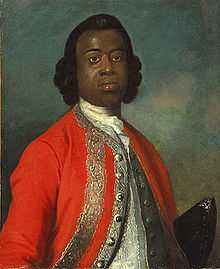William Ansah Sessarakoo

William Ansah (or Unsah) Sessarakoo (fl. 1736–1749), the son of a wealthy Ghanaian and African slave trader, is best known for being released from slavery in the West Indies and taken to London, where he became a celebrity.
Sessarakoo was the son of a wealthy brafo (chief) of the Ghanaian Fante people, based close to a fort established as a trading post by the Dutch at Annamaboe on the West African Gold Coast (also called Anomabu or Anomabo, in modern Ghana).[1][2] His father, known as "John Corrente", was a trader in gold and slaves: he decided to send his son and a companion to Europe to learn European ways of business, to improve his trading prospects. The European captain engaged to transport Sessarakoo took him to Bridgetown in Barbados, where he sold him into slavery. The captain died soon afterwards, but Sessarakoo's father discovered the treachery, and refused to deal with English traders until his son was released. To avoid diplomatic problems, the Royal African Company arranged for local merchants to pay for Sessarakoo to be freed.[3]
Sessarakoo was taken to London, where he came under the protection of George Montagu-Dunk, 2nd Earl of Halifax, President of the Board of Trade. He was treated as a foreign prince, the "Prince of Annamaboe", and introduced to George II. He became a celebrity, and was compared to Oroonoko, the fictional African prince in the novel by Aphra Behn who was also sold into slavery. He attended a performance of Thomas Southerne's play based on Behn's novel. His portrait was painted in oils by Gabriel Mathias in 1749, and his story was the inspiration for William Dodd's 1749 poem The African Prince.[4] His memoirs were published in 1750 as The Royal African: or, Memoirs of the Young Prince of Annamaboe. He later returned to Africa.
References
- ↑ Ghana Slave Forts. ship-wrecks.co.uk
- ↑ Castles in Ghana :: Fort William – Anomabu. shoutghana.com
- ↑ Laura Brown (2003). Fables of Modernity: Literature and Culture in the English Eighteenth Century. Cornell University Press. p. 183. ISBN 978-0-8014-8844-3.
- ↑ Srinivas Aravamudan (1999). Tropicopolitans: Colonialism and Agency, 1688–1804. Duke University Press. p. 251. ISBN 978-0-8223-2315-0.
Further reading
- Portraits at the National Portrait Gallery
- Between Worlds at the National Portrait Gallery
- The Royal African: or, Memoirs of the Young Prince of Annamaboe
- Hakim Adi, West Africans in Britain: 1900–1960
- Wylie Sypher, The African Prince in London, Jour. Hist. Ideas, 2, 2 (1941) 237–47
|